
Chemistry
Silver nanoparticles – a problem for the environment?
There has been no method so far to investigate the influence of the particles in complex surroundings. Initial results with a new method show that the particles behave differently than expected.
Silver particles have an antibacterial and anti-inflammatory effect. As a result, they are used widely, for example as coatings for wound dressings, as odour inhibitors in sportswear, and in food packaging. From there, they are regularly released into the environment. “When sportswear is washed, in each wash 50 per cent of the silver particles contained in it are released into the water,” says Professor Kristina Tschulik, a chemist in the Ruhr Explores Solvation Cluster of Excellence at RUB. “They ultimately end up in the sea.” What happens to them there is still largely unknown.
This is because the tiny particles, which are only a few nanometres in size, are difficult to examine – especially when they are present in low concentrations in a complicated environment such as seawater. “There are many sources of interference here, such as salts and algae,” explains Tschulik. Conventional methods for analysing nanoparticles cannot cope with this because they only work in a high vacuum.
Testing of anti-breath odour spray
Kristina Tschulik’s Research Group for Electrochemistry and Nanoscale Materials has developed a new process that changes this. It can detect individual nanoparticles in solution and analyse what happens to them. For this purpose, they combined a previously established electrochemical method with a spectroscopic technique.
To show that the method is robust against sources of interference, the researchers used water samples from an untouched Canadian fjord in the first step. Although this water contained salts, algae and other interfering factors, it did not contain any industrial impurities.
These were added by the researchers themselves in the laboratory: they bought a silver nanoparticle spray on the Internet, which was sold to disinfect cutlery and as a remedy for bad breath in dogs. They sprayed this into the fjord water and used the electrochemical method to investigate whether they could detect the particles – which they could.

Using the combined spectro-electrochemical method, the chemists analysed in further studies what happens to silver particles in salty water. It had previously been assumed that they would dissolve in the water.
Particles clump together
This assumption could not be confirmed; the particles clump together and transform to silver chloride. “They would therefore sink to the bottom and sediment,” concludes Tschulik. “Hence, they would be removed from the seawater, but we would then have to consider what long-term consequences these heavy metal deposits could have for marine inhabitants living near the bottom.”

The more we use nanoparticles, the more important it is for us to be able to assess their effects.
Kristina Tschulik
Because there was no previous method for studying nanoparticles in such complex environmental media, little is known about their impact on the environment. “We should not panic based on such an individual result,” says Kristina Tschulik, recalling that different nanoparticles can behave very differently, so it is not possible to apply the results of few studies to all nanoparticles. But: “The more we use nanoparticles, the more important it is for us to be able to assess their effects,” the researcher adds.
No obligation to monitor so far
This would be possible with the method used by Tschulik’s group – not only in seawater, but also, for example, in process wastewater from industrial companies. “But, as long as there are no established measuring techniques and no legal obligations to detect nanoparticles, most companies will, of course, not do so,” explains Tschulik. Should the legislator introduce such monitoring, a sensor for measuring them would already be available.